Chapter 18.74
FERNDALE LANDSCAPE STANDARDS
Sections:
18.74.010 Purpose of landscape standards.
18.74.030 Required plant materials.
18.74.040 Description of landscape standards.
18.74.060 Criteria for adjustment.
18.74.070 Installation and maintenance.
18.74.100 Plant materials standards.
18.74.105 Credit for preservation of existing vegetation.
18.74.110 Preservation of existing vegetation.
18.74.130 Vision clearance area landscaping.
18.74.140 Parking lot landscape standards.
18.74.150 Landscape maintenance bonds/savings assignments.
18.74.160 Replacement required.
18.74.010 Purpose of landscape standards.
Landscape standards are designed to:
A. Improve the appearance and visual character of the community.
B. Promote compatibility between all land uses by reducing the visual, noise, and lighting impacts of development on adjacent properties.
C. Unify development, and enhance and define public and private spaces on a site.
D. Reduce the visual impact of glare, headlights, and parking lot lights from the public right-of-way and from adjoining properties.
E. Reduce the area of impervious surfaces.
F. Reduce the level of carbon dioxide in areas of heavy vehicle use and return pure oxygen to the atmosphere.
G. Encourage safe and efficient on-site circulation.
H. Encourage the retention and use of existing vegetation.
I. Provide shade as a means of mitigating heat and exposure in parking lots and other paved areas.
J. Encourage efficient water use and conservation.
K. Encourage a pedestrian-oriented street environment.
L. Where feasible, combine stormwater treatment and detention facilities with required landscaping in a cost effective, attractive manner. (Ord. 1933 § 4 (Exh. 4), 2016; Ord. 1699 § 1, 2012; Ord. 1400 § 2, 2006)
18.74.020 Applicability.
The landscape standards reflected in Tables 18.74A and 18.74B establish minimum landscape requirements that apply to any development, except:
A. Minor building alterations.
B. Site improvements for improved public access.
C. Change of use not affecting exterior of building.
D. Single-family residential construction.
1. Landscaping associated with on-site rain gardens or bio-swales on single-family residential lots shall be subject to the landscaping and vegetation requirements (where present) of the original approved design.
|
|
L-1 Basic |
L-2 Low Screen |
L-3 High Screen |
L-4 High Wall |
L-5 Partial Screen Fence |
L-6 Full Screen Fence |
|---|---|---|---|---|---|---|
|
In setback areas of multiple-family development (except as otherwise noted) |
X |
|
|
|
|
|
|
Multiple-family parking (where parking areas abut interior property line or right-of-way) |
|
X |
|
|
|
|
|
Recycling and garbage areas within or adjacent to vehicular use areas in the RMM, RMH and RO zones |
|
|
X* |
|
|
X* |
|
Property lines within 75 feet of delivery and loading areas on commercially zoned lots abutting residential zones |
|
|
|
X |
|
|
|
Property lines within 75 feet of delivery and loading areas on industrially zoned lots abutting residential zones |
|
|
|
X |
|
|
|
Street frontage of commercial development where frontage is not occupied by parking (except in pedestrian-oriented zones (CC, UR, MXD, GB, and RRZ) when zero street setbacks are used) |
X |
|
|
|
|
|
|
Outdoor merchandise display areas of greater than 300 square feet in MXD, GB, C7/RR and RO zones, excluding plant merchandise displays |
|
X* |
X* |
X* |
X* |
X* |
|
|
|
|
|
|
X |
|
|
Parking area landscaping along a public or private right-of-way |
|
X |
|
|
|
|
|
Parking area driveway or primary circulation route landscaping |
|
X |
|
|
|
|
|
Parking and loading areas for institutional and commercial uses adjacent to residentially zoned property |
|
|
X* |
X* |
|
|
|
Campground or recreational vehicle park street frontage screening |
|
|
X |
|
|
|
|
Manufactured home park property boundaries |
|
|
X* |
X* |
|
|
|
Electrical substation unless fully enclosed within a building |
|
|
X |
|
|
|
|
Telecommunication or satellite relay station unless fully enclosed within a building |
|
|
X |
|
|
|
|
Pump station, wellhead, tank-style reservoir, and other water or sewer facilities unless fully enclosed within a building |
|
|
X* |
|
|
|
|
Vehicle or equipment storage yard in RO, RMM, RMH or any RS zone |
|
|
X* |
|
X* |
|
|
Interior property lines for essential public facility sites |
|
|
X* |
X* |
X* |
X* |
* Specific standard required is subject to administrative review.
(Ord. 2151 § 1 (Exh. 1), 2020; Ord. 1933 § 4 (Exh. 4), 2016; Ord. 1699 § 1, 2012; Ord. 1400 § 2, 2006)
18.74.025 Buffering.
Buffering between zones is required based on the provisions of Table 18.74B.
A. Buffering requirements between zones is the requirement of each developing or redeveloping property.
1. Cooperative Agreements. Developers are encouraged to enter into cooperative agreements with adjacent properties to develop a single buffer with joint responsibility for maintenance. This eliminates the need for double buffering.
2. Double Buffering. It is the intent of this code to require double buffering to maximize benefit and equitably burden each property owner where cooperative agreements are not achieved. Where double buffering would create an alleyway or “no man’s land” between walls, fences, or linear plantings, an alternative landscape standard shall be applied so as to accentuate the benefits of a barrier without creating the negative effects of an isolated alleyway.
B. Wetlands/Open Space. Where wetlands, riparian areas, and other open space create an effective buffer that is consistent with the purpose of this chapter, the buffering requirement may be waived or modified upon approval of the Zoning Administrator.
C. Residential Buffers. Where buffers required by Table 18.74B or the PUD ordinance (Chapter 18.68 FMC) occur on residential plats, the buffer shall be on a separate parcel or tract and shall be owned and maintained by a homeowner’s association.
D. Large Retail Buffers.
1. For retail establishments with buffers along interior property lines that exceed 12 feet in width, as required by the City of Ferndale design guidelines, the L-3 planting requirements shall be modified to require two rows of trees within the required landscape buffer. Tree rows shall be staggered. Landscaping here shall also comply with the City’s approved retail design manual.
2. For retail establishments with buffers along interior property lines that exceed 20 feet in width, as required by the City of Ferndale design guidelines, the L-3 planting requirements shall be modified to require two rows of trees and a four-foot-high berm within the required landscape buffer. Tree rows shall be staggered. Landscaping here shall also comply with the City’s approved retail design guidelines and standards (Chapter 18.58 FMC).
E. Planned Unit Developments. PUD buffers may be required through Chapter 18.68 FMC. Buffer width shall be consistent with the requirements therein. Landscaping within the required buffer shall at a minimum be consistent with the L-3 and/or L-4 standard as appropriate for the particular PUD use.
|
|
MXD** |
GB |
RR |
LI** |
M** |
RMM/RMH** |
All RS |
RO |
UR |
CC |
|---|---|---|---|---|---|---|---|---|---|---|
|
MXD** |
|
|
|
L-2 L-3 |
L-2 L-3 |
L-1 L-2 L-3 |
L-3 |
L-3* |
|
|
|
GB |
|
|
|
|
|
L-3 |
L-3 |
L-3* |
|
|
|
RR |
|
|
|
|
|
|
|
|
|
|
|
LI** |
L-2 L-3 |
|
|
|
|
L-3 |
L-3 |
L-3* |
|
|
|
M** |
L-2 L-3 |
|
|
|
|
L-3 |
L-3 |
L-3* |
|
|
|
RMM/RMH** |
L-1 L-2 L-3 |
L-3 |
|
L-3 |
L-3 |
|
|
|
|
|
|
All RS |
L-3 |
L-3 |
|
L-3 |
L-3 |
|
|
|
|
|
|
RO |
L-3* |
L-3* |
|
L-3 |
L-3 |
|
|
|
|
|
|
UR |
L-3*** |
|
|
|
|
L-3*** |
|
L-3*** |
|
|
|
CC |
|
|
|
|
|
L-3*** |
|
L-3*** |
|
|
* When existing or proposed RO use is residential; otherwise L-1 or L-2 may be approved.
** Specific buffering requirement based on uses as determined by the Zoning Administrator.
*** When frontage is not occupied by a structure.
(Ord. 2151 § 1 (Exh. 1), 2020; Ord. 1933 § 4 (Exh. 4), 2016; Ord. 1699 § 1, 2012; Ord. 1400 § 2, 2006)
18.74.030 Required plant materials.
Plants used within required landscape areas shall be locally hardy, noninvasive plants with a mature size and growth habit appropriate to the location and use. The City of Ferndale maintains the City of Ferndale plant materials list to aid in the selection of plant materials. Landscape plans may utilize plants not included on the City of Ferndale plant materials list, including those plants that are appropriate for stormwater detention and treatment uses, where applicable and recommended by professional stormwater specialists. (Ord. 1933 § 4 (Exh. 4), 2016; Ord. 1699 § 1, 2012; Ord. 1400 § 2, 2006)
18.74.040 Description of landscape standards.
A. Basic Landscape Standard (L-1). A landscape treatment to enhance the appearance of street frontages and yard areas. A linear effect is not the goal, but a visually pleasing, park-like effect should be achieved. The minimum width shall be consistent with the setback area unless otherwise specified herein.
1. Required Plant Materials. Basic landscape standard (L-1) requires the installation and maintenance of all of the following:
a. One tree per 30 linear feet as measured along the front lot line.
b. Six shrubs per 30 linear feet as measured along the front lot line.
c. The City encourages the use of landscaping other than turf for the aesthetic benefit to the community. Drought-tolerant, low-maintenance vegetative ground cover is encouraged.
However, this requirement does not preclude the use of stormwater best management practices that utilize turf cover as a method of stormwater mitigation.
d. Living plant materials covering a minimum of 70 percent of the required landscape area within five years of planting.
The required plant materials may be installed in the required area in any arrangement and do not need to be linear in design.
2. Exceptions to Required Plant Materials. An exception to the requirement in subsection (A)(1)(a) of this section shall be granted if, excluding any required parking area landscaping, the landscape area required to comply with the L-1 basic landscape standard is located entirely within 15 feet of a building.
B. Low Screen Landscape Standard (L-2). A landscape treatment to enhance the visual appearance of linear spaces while allowing high visibility and an open effect. Low screen landscape areas shall be a minimum of seven feet wide unless otherwise specified herein.
1. Required Plant Materials. Low screen landscape standard (L-2) requires the installation and maintenance of all of the following:
a. Low shrubs to form a continuous screen at least 24 inches high within three years and maintained at a height not to exceed 42 inches.
b. One canopy tree per 30 linear feet as measured along the street lot line.
c. Living plant materials covering a minimum of 70 percent of the required landscape area within three years of planting.
d. The City encourages the use of landscaping other than turf for the aesthetic benefit to the community. Drought-tolerant, low-maintenance vegetative ground cover is encouraged. However, this requirement does not preclude the use of stormwater best management practices that utilize turf cover as a method of stormwater mitigation.
e. A masonry wall or a berm between 30 and 42 inches high shall be permitted as a substitute for the required low shrubs, but the trees and other plant materials are still required. When applied along street frontage, the masonry wall is to be placed farthest from the street with the required landscaping in between the wall and street. When applied along an abutting property, the masonry wall may be placed along the interior lot line.
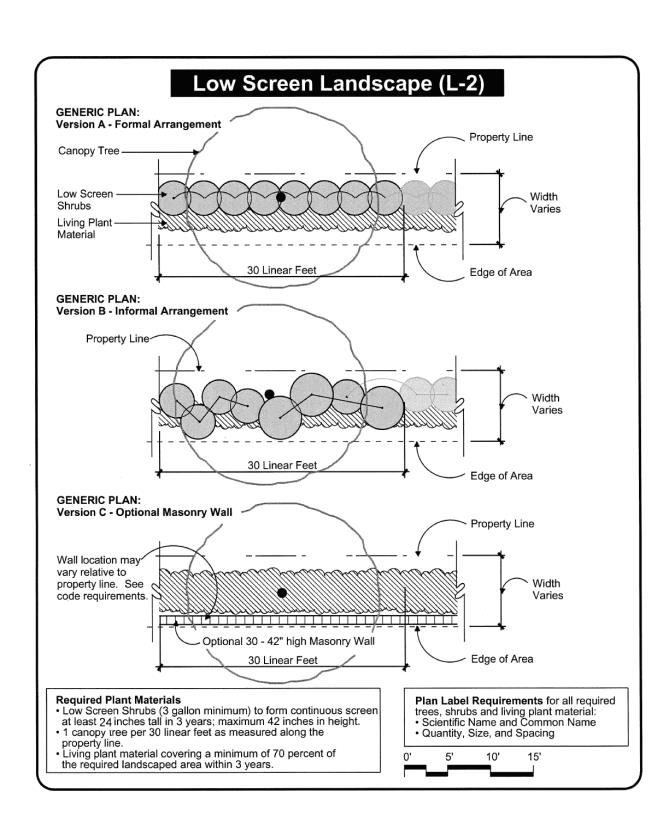
C. High Screen Landscape Standard (L-3). A landscape treatment to create a living visual barrier and insert a psychological separation. A high screen landscape area shall have a minimum width of seven feet unless otherwise specified herein.
1. Required Plant Materials. High screen landscape standard (L-3) requires the installation and maintenance of all of the following:
a. Evergreen shrubs that are in at least five-gallon containers at the time of planting to form a continuous screen, at least six feet high, within five years of planting.
b. One tree per 30 linear feet as measured along interior lot lines. Evergreens or canopy trees may be used as appropriate to provide the desired screening.
c. Living plant materials covering a minimum of 70 percent of the required landscape area within five years of planting.
d. The City encourages the use of landscaping other than turf for the aesthetic benefit to the community. Drought-tolerant, low-maintenance vegetative ground cover is encouraged. However, this requirement does not preclude the use of stormwater best management practices that utilize turf cover as a method of stormwater mitigation.
e. A masonry wall at least six feet high shall be permitted as a substitute for the shrubs but the trees and other plant materials are still required. When this landscape standard is applied along street frontage, the screen or wall is to be placed farthest from the street with the required landscaping in between the wall and street. When along a street frontage, vines shall be planted a maximum of eight feet on center on the streetward side of the wall. When applied along an abutting property, the masonry wall may be placed along the interior lot line.
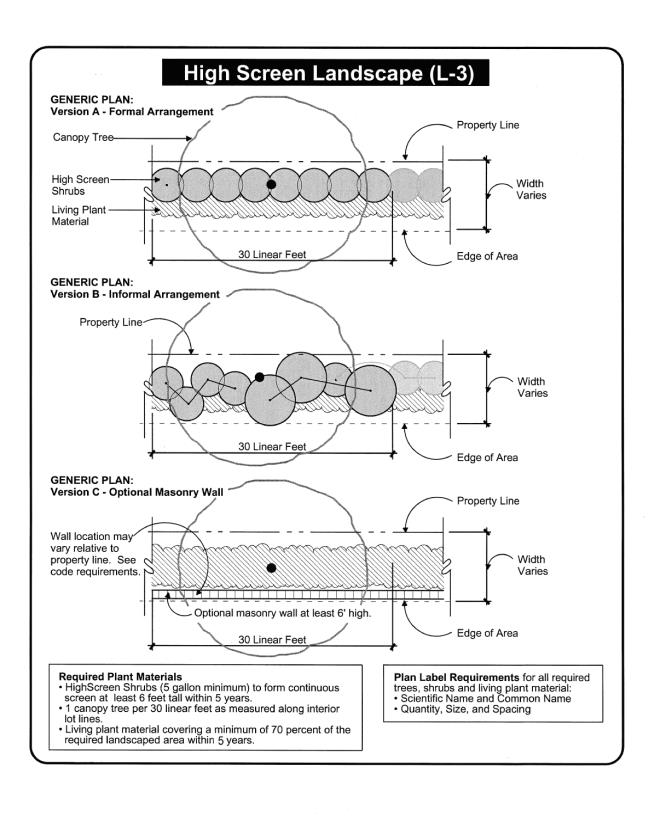
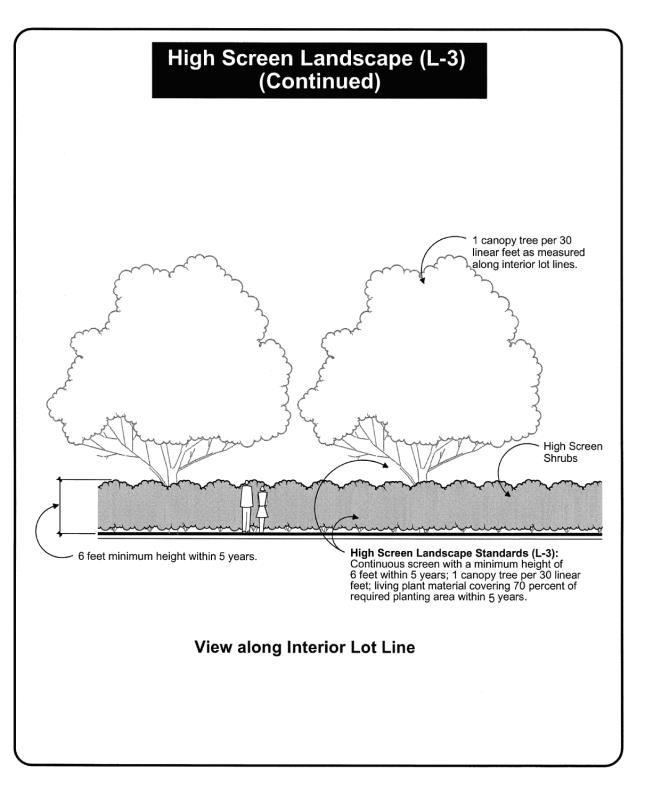
D. High Wall Landscape Standard (L-4). A landscape treatment to create a visual separation that provides noise buffering and added security and privacy. A high wall landscape area shall have a minimum width of seven feet unless otherwise specified herein.
1. Required Materials. High wall landscape standard (L-4) requires the installation and maintenance of all of the following:
a. Masonry wall at least six feet high with a maximum height of eight feet. When applied along street lot lines, the wall shall be placed farthest from the street with the required landscaping in between the wall and the street. When along a street frontage, vines shall be planted a maximum of eight feet on center on the streetward side of the wall. When abutting an adjacent parcel, the wall may be placed along the interior lot line.
b. One tree per 30 linear feet as measured along interior lot lines. Evergreens or canopy trees may be used as appropriate to provide the desired screening.
c. Four high shrubs or vines are required per 30 linear feet of wall.
d. Living plant material must cover a minimum of 70 percent of the required landscape area within five years of planting.
e. The City encourages the use of landscaping other than turf for the aesthetic benefit to the community. Drought-tolerant, low-maintenance vegetative ground cover is encouraged. However, this requirement does not preclude the use of stormwater best management practices that utilize turf cover as a method of stormwater mitigation.
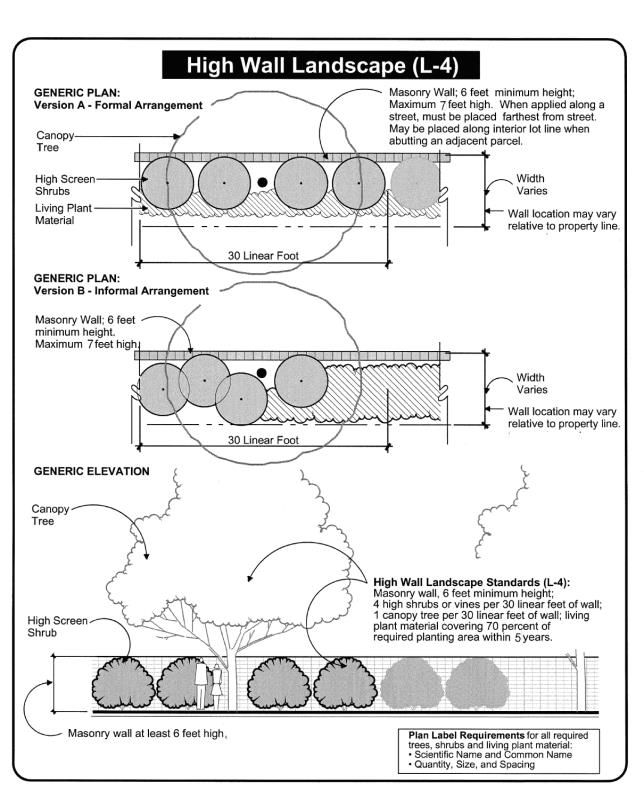
E. Partial Screen Fence Landscape Standard (L-5). A landscape treatment to create a psychological definition of separate spaces while allowing some visibility for security purposes. A partial screen fence landscape area shall have a minimum width as necessary to allow for maintenance of the fence unless otherwise specified herein.
1. Required Materials. Partial screen fence landscape standard (L-5) requires the installation and maintenance of fences at least six feet high that are at least 50 percent sight-obscuring, such as a dark-colored, vinyl-coated chain link fence. Vines are permitted on fences to fulfill the requirement for a screening fence provided they would be 50 percent sight-obscuring within five years of planting. Fences may be made of wood, metal, masonry, or other permanent materials.
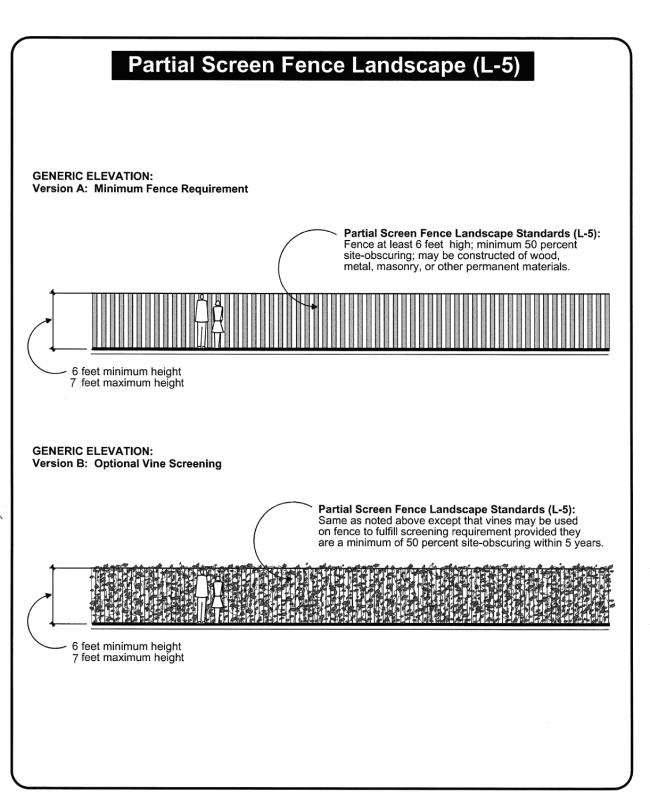
F. Full Screen Fence Landscape Standard (L-6). A landscape treatment to create a complete visual break between separate spaces. A full screen fence landscape area shall have a minimum width as necessary to allow for maintenance of the fence unless otherwise specified herein.
1. Required Materials. Full screen fence landscape standard (L-6) requires the installation and maintenance of fences at least six feet high with a maximum height of seven feet that are 100 percent sight-obscuring. Fences may be made of wood, metal, masonry or other permanent materials.
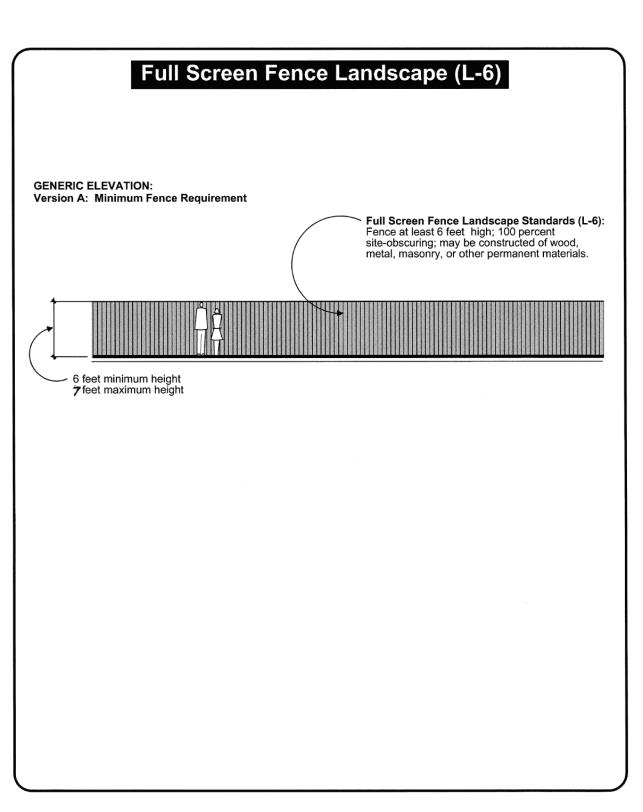
(Ord. 1933 § 4 (Exh. 4), 2016; Ord. 1699 § 1, 2012; Ord. 1400 § 2, 2006)
18.74.050 General provisions.
Rain gardens, fully landscaped infiltration basins, vegetated swales and other water quality features may be counted as required landscape areas, provided the required planting standard can be substantially achieved. Landscaping design that encourages rainwater retention and infiltration is encouraged.
The use of native plants is encouraged. Flexibility in interpreting planting standards shall be applied where necessary to accommodate the unique growth habits of native plants and the limits on availability of appropriately sized native plant specimens.
Drought-tolerant plantings are encouraged. Water conservation is a primary purpose of this code. However, if any planting used for required landscaping is not drought-tolerant, an irrigation system shall be installed to ensure plant survival (see FMC 18.74.080).
Outdoor art, street furniture, and landscape architectural elements are encouraged. The Zoning Administrator may consider these as substitution for required plant elements. Creativity in landscape design, consistent with the requirements and purpose of this code, is encouraged.
When interpreting these code provisions for compliance, the Zoning Administrator shall consider the intent of the specific landscaping standards to determine compliance when a specific application varies from the prescriptive requirements contained herein. The Zoning Administrator shall first consider whether the specific desired effect of the standard (aesthetic, sight screening, etc.) is achieved by the proposed landscaping, followed by a review for strict compliance with the standards. (Ord. 1933 § 4 (Exh. 4), 2016; Ord. 1699 § 1, 2012; Ord. 1400 § 2, 2006)
18.74.060 Criteria for adjustment.
The landscape standards may be adjusted if consistent with the purpose of the landscape standards as determined by the Zoning Administrator. If adjustment is proposed, the applicant shall be required to submit a landscaping plan for the entire site, identifying those location(s) in which adjustment is requested, and including a justification for such adjustment. (Ord. 1933 § 4 (Exh. 4), 2016; Ord. 1699 § 1, 2012; Ord. 1400 § 2, 2006)
18.74.070 Installation and maintenance.
Proper installation is critical to landscape plant establishment and survival. Plants shall be installed as appropriate for their species, size, and growth habit. Plant materials shall be properly supported to ensure survival. Support devices such as guy wires or stakes shall not interfere with vehicular or pedestrian movement. Maintenance of landscaped areas is the ongoing responsibility of the property owner. All landscaping shall be installed and maintained to protect it from vehicular damage through the use of curbing and to provide adequate vision clearance. Required shrubs and trees shall not be pruned or sheared below their code-required spread or height. (Ord. 1933 § 4 (Exh. 4), 2016; Ord. 1699 § 1, 2012; Ord. 1400 § 2, 2006)
18.74.080 Irrigation.
An automatically controlled irrigation system shall be provided for all plant materials used to meet these landscape standards. The use of drought-tolerant plant species may preclude the need for irrigation. Drip irrigation and low-gallon systems are encouraged for nonturf areas. The irrigation systems shall not provide water to unplanted areas, or to areas where existing native plants have been preserved. The irrigation systems shall be maintained and operated in a manner that promotes the health and appearance of the plant material while minimizing water use and avoiding excessive runoff. It is a primary purpose of this code to minimize the need for irrigation, and to minimize waste of water through improperly designed and operated irrigation systems. A separate water connection will be required for landscape irrigation systems. (Ord. 1933 § 4 (Exh. 4), 2016; Ord. 1699 § 1, 2012; Ord. 1400 § 2, 2006)
18.74.090 Landscape plans.
Landscape plans shall show that all proposed landscaped areas and landscape materials comply with the applicable landscape standards in this land use code.
It is strongly encouraged that landscape plans are prepared by a landscape architect or qualified nurseryman. Landscape plans must demonstrate satisfaction of the City of Ferndale landscape standards.
A. Submittal Requirements. Preliminary landscape plans shall be submitted simultaneous with the submittal of site plan review applications. Final landscaping plans shall be submitted simultaneous with or before submittal of building permit applications. Should a landscaping plan propose to integrate low impact development stormwater methodology, final approval will not be provided until review of civil drawings related to stormwater.
No building permits shall be issued prior to Zoning Administrator approval of a landscape plan.
Landscaping plans shall be consistent with the following requirements:
1. Landscaping plan shall clearly indicate the location of all proposed plants and other landscape elements such as boulders, furniture, fountains, etc.
2. Landscaping plan shall include a legend identifying each plant by species including common and botanical name. Plans shall include plant size or pot size details for each plant.
3. Landscaping elements shall be shown in relation to major site features such as parking areas, roads, and structures.
4. Landscaping plan shall be at the same scale as the approved site plan and shall use the site plan as an overlay. Typically this will be on a full-size plan sheet (24-inch by 36-inch).
5. Irrigation system details must be included in the submittal. They may be illustrated on a separate sheet or on the landscaping plan. (Ord. 1933 § 4 (Exh. 4), 2016; Ord. 1699 § 1, 2012; Ord. 1400 § 2, 2006)
18.74.100 Plant materials standards.
A. Shrubs and Ground Cover. All required plant materials shall be of sufficient size and number to meet the required 70 percent coverage standard within three years according to the type of landscape standard being addressed. Mulch is not a substitute for ground cover plants.
All required shrubs shall be in at least three-gallon containers prior to planting, unless otherwise specified herein. All required ground cover shall be in at least one-gallon containers prior to planting, unless otherwise specified herein.
B. Trees. Except where one or the other is specified elsewhere in this code, trees may be either deciduous or evergreen varieties. Required canopy trees at the time of planting must be fully branched and have a minimum diameter of two inches DBH. Required evergreen trees at the time of planting must be fully branched and a minimum of six feet in height. (Ord. 1933 § 4 (Exh. 4), 2016; Ord. 1699 § 1, 2012; Ord. 1400 § 2, 2006)
18.74.105 Credit for preservation of existing vegetation.
Variable credit shall be allowed for preservation of mature trees, groves of small trees, and mature native bushes and shrubs. No credit shall be provided for the preservation of existing invasive species such as Himalayan blackberry. The Zoning Administrator shall determine the value of the preserved vegetation based on visual impact and area required for preservation. Provided that the existing vegetation substantially achieves the goals of the landscaping that would otherwise be required, the Zoning Administrator may also provide credits based on a demonstration by a qualified third party that the existing vegetation provides stormwater treatment or detention, and that the vegetation will be retained and protected/maintained for that purpose. Approved preservation shall relieve the contractor/developer from installing landscaping in relation to the area preserved and the visual impact of the preserved vegetation. (Ord. 1933 § 4 (Exh. 4), 2016; Ord. 1699 § 1, 2012; Ord. 1400 § 2, 2006)
18.74.110 Preservation of existing vegetation.
A. New developments with existing vegetation on the site are encouraged to preserve and integrate the vegetation into the design of the development. The following credit shall be given for preservation of existing vegetation:
1. For each mature tree preserved on the development site, the development will be relieved from planting requirements for at least two trees as otherwise required by this code. Relief from additional planting may be permitted in relation to the size of the tree(s) retained on the site at the discretion of the Zoning Administrator. Relief is generally applied at a rate of one tree planting for every two diameter-inches preserved.
2. For each square foot of root area preserved in an unaltered state around the tree, the development will be relieved from providing two square feet of planting area as specified in FMC 18.74.140(E), Interior Parking Area Landscaping.
3. Areas containing preexisting native vegetation shall not be required to provide irrigation.
B. Owners/developers who choose to preserve significant vegetation on the site, including mature trees, shall:
1. Submit a detailed tree preservation and planting plan, with the development permit application, that shows the trees and other vegetation to be preserved. The Zoning Administrator shall determine whether the vegetation to be preserved meets the intent of this code, and to what degree it offsets planting requirements.
2. Follow the Zoning Administrator’s recommendations to ensure that no cutting, filling, compaction or other disturbance of soil takes place in an area that exceeds 30 percent of the critical root zone area of the tree. Alteration of the soil within the critical root zone area shall require submittal of a tree preservation plan for mitigative actions to preserve the tree. The tree preservation plan shall address drainage compaction, fertilization, pruning and design measures that will be taken to ensure the continued health of the tree before and after the critical root zone area is disturbed.
3. Execute an agreement with the City to replace any significant tree that dies within five years of the date the agreement is signed. For trees determined to be significant, replacement trees shall be provided at the rate of two new trees for each tree lost. A reasonable location shall be approved by the City prior to planting replacement trees. If a reasonable location for the replacement trees cannot be found on the site, the value equal to the number of trees credited shall be given to the City for the planting of trees on public property. (Ord. 1933 § 4 (Exh. 4), 2016; Ord. 1699 § 1, 2012; Ord. 1400 § 2, 2006)
18.74.120 Street trees.
All development and redevelopment of property in the pedestrian-oriented zones as listed in Table 18.74A shall plant downtown street trees in the right-of-way, or adjacent thereto. Such trees shall be placed not less than 30 feet on center, and shall take into account trees on adjacent parcel frontages. Planting requirements may be adjusted, and species substituted, at the discretion of the Zoning Administrator. (Ord. 1933 § 4 (Exh. 4), 2016; Ord. 1699 § 1, 2012; Ord. 1400 § 2, 2006)
18.74.130 Vision clearance area landscaping.
All landscaping within vision clearance areas shall comply with FMC 18.72.040. Where high shrubs or other sight-obscuring screening is required by provisions of this land use code, low screening shall be substituted within vision clearance areas. (Ord. 1933 § 4 (Exh. 4), 2016; Ord. 1699 § 1, 2012; Ord. 1400 § 2, 2006)
18.74.140 Parking lot landscape standards.
A. Applicability of Parking Area Landscape Standards.
1. General Provisions. Subject to any exceptions herein, the standards in this code apply to all parking areas, including carports, which provide for six or more spaces except for the following:
a. A parking area for a single-family dwelling, accessory dwelling, or duplex.
b. A legal nonconforming parking area. See subsection (A)(2) of this section.
2. Provisions Applicable to Legal Nonconforming Parking Areas. Parking areas with legal nonconforming landscaping are subject to the following parking area landscape standards:
a. When a new building is constructed on a site with a preexisting parking lot, the parking area landscape standards herein shall apply to a portion of the parking area sufficient to meet the minimum required parking for the new building and to any additional parking area proposed by the applicant to serve the building.
b. When a building is expanded, the parking area landscape standards herein shall apply to a portion of the parking area that is sufficient to meet the minimum required parking spaces for the expanded area of the building and to any additional parking area proposed by the applicant to serve the expanded area of the building.
c. When a legal nonconforming parking area is physically expanded in size (not simply re-striped to increase, decrease, or reconfigure the number of parking spaces), the parking area landscape standards herein shall apply only to the expanded portion of the parking area.
d. When a legal nonconforming gravel parking area is paved, the parking area landscape standards herein shall apply only to the paved portion of the parking area.
e. When modifications to nonconforming parking areas trigger modifications or expansions to stormwater facilities, the applicant may propose integrated low impact development storm facilities within the parking lot without automatically triggering full compliance with these landscaping standards.
i. When low impact development storm facilities are proposed in place of required or existing landscaping, such storm facilities must remain consistent with the requirements of this chapter.
B. General Parking Area Landscape Standards. Canopy trees shall be required at the minimum rate of one tree for every 3,000 square feet of paved vehicular use areas on the site and shall be distributed throughout the paved area. Trees shall be planted in a landscaped area such that the tree trunk is at least three feet from any outside curb edge or paved area. Vehicular use areas include parking spaces, driveways, interior roadways, loading areas, and fleet vehicle storage areas. Large-scale coniferous trees may be substituted for required canopy trees at a maximum rate of 10 percent. Parking area screening requirements may be achieved through a combination of change of grade and use of plant materials. The use of berms or drainage swales is acceptable, as is lowering the grade of the parking area. Rain gardens, fully landscaped infiltration basins, vegetated swales and other water quality features may be counted as required landscape areas provided the required planting standard can be substantially achieved. Landscaping design that encourages rainwater retention and infiltration is encouraged.
C. Parking Area Landscaping Along Street and Driveway Entrances.
1. Parking areas within 25 feet of a street, except an alley, shall provide a landscape strip between the street and the parking areas as follows:
a. In all areas, except the RMM, RMH and RO zones, a landscape strip at least seven feet in width shall be provided.
b. Within the RM RMM, RMH and RO zones, a landscape strip at least five feet in width shall be provided.
c. Landscape strips along a street may be pierced by pedestrian and vehicular accessways. Landscape strips along a street shall be landscaped as per Table 18.74A.
2. Parking area driveway entrances, except those entering from alleys, shall be provided with a landscape strip at least seven feet in width, measured from the outside edges of six-inch-wide curbs. These landscape strips shall be at least the length of a full parking space, or such distance necessary to heighten entryway visibility and improve parking area circulation. Entrance driveway landscape strips shall be landscaped according to the low screen landscape standard (L-2) except the height of the low screen within vision clearance areas shall not exceed 24 inches.
D. Perimeter Parking Area Landscaping.
1. Along the perimeter of the parking area, a landscape strip, at least seven feet in width, measured from the outside edge of a six-inch-wide curb, shall be provided. The landscape strip may be pierced by pedestrian and vehicular accessways.
Where abutting lots share parking and/or loading areas, the perimeter of these shared areas shall be considered the outside of the parking area. Perimeter landscaping shall not be required along the interior lot lines of the lots that are sharing parking and/or loading areas.
2. All parking areas shall provide perimeter landscaping according to low screen landscape standard (L-2), except as otherwise specified in Table 18.74A.
E. Interior Parking Area Landscaping.
1. In addition to the landscaping required in subsections (C) and (D) of this section, landscaping shall be provided within the interior of surface parking areas for 50 or more motor vehicles so as to:
a. Improve the visual qualities of these areas.
b. Delineate and define circulation movements of motorists and pedestrians.
c. Improve air quality.
d. Encourage energy conservation by reducing solar heat gain.
e. Where applicable, to provide stormwater detention and treatment.
2. Parking area landscaping shall be provided according to Table 18.74C, Interior Parking Area Landscaping.
|
Total Number of Spaces in Parking Area |
Minimum Interior Parking Area Landscape Area |
|---|---|
|
50 to 99 spaces |
15 square feet per parking space |
|
100 or more spaces |
22 square feet per parking space |
3. A continuous landscape strip or raised pedestrian path shall be provided between every six rows of parking. The landscape strip or pedestrian path shall be a minimum of seven feet in width, measured from the outside edge of a six-inch-wide curb.
4. Planting islands shall be provided at the ends of each parking row and at intervals within parking rows so that no parking stall is more than 45 feet from a planting island, or no more than 10 parking spaces may be allowed in a row without the installation of a planting island. Staggered planting islands may be installed when two rows of parking face each other; provided, that overall landscaping ratios are adhered to and no more than 10 parking spaces exist between a planter island on one or both sides of the parking configuration. Planting islands shall be at least seven feet in width, as measured from the outside edge of a six-inch-wide curb, and a minimum area of 140 square feet. Each of these islands shall provide at least one canopy tree. Low-maintenance vegetative ground cover shall be planted at a spacing of 12 inches on center within the planter bed. Mulch shall be installed to suppress weeds, but shall not substitute for vegetative ground cover.
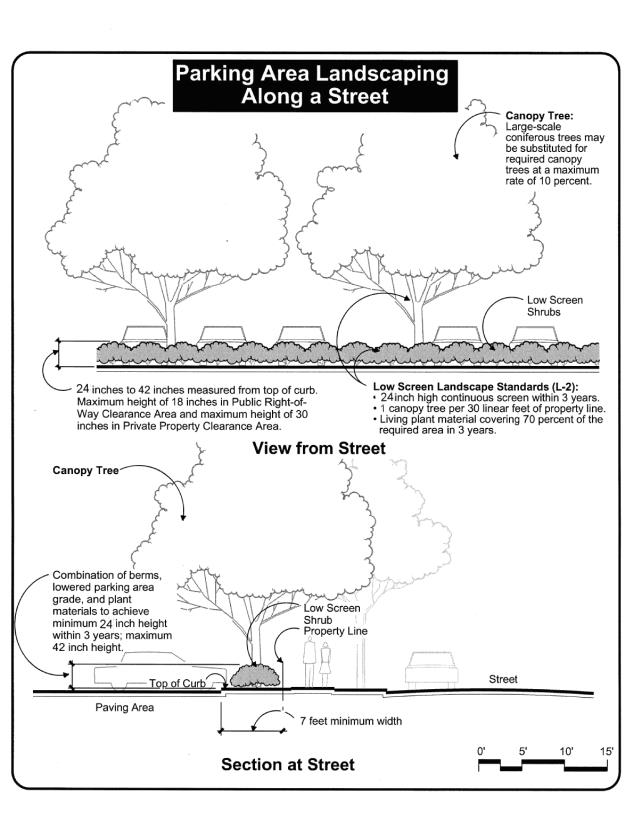
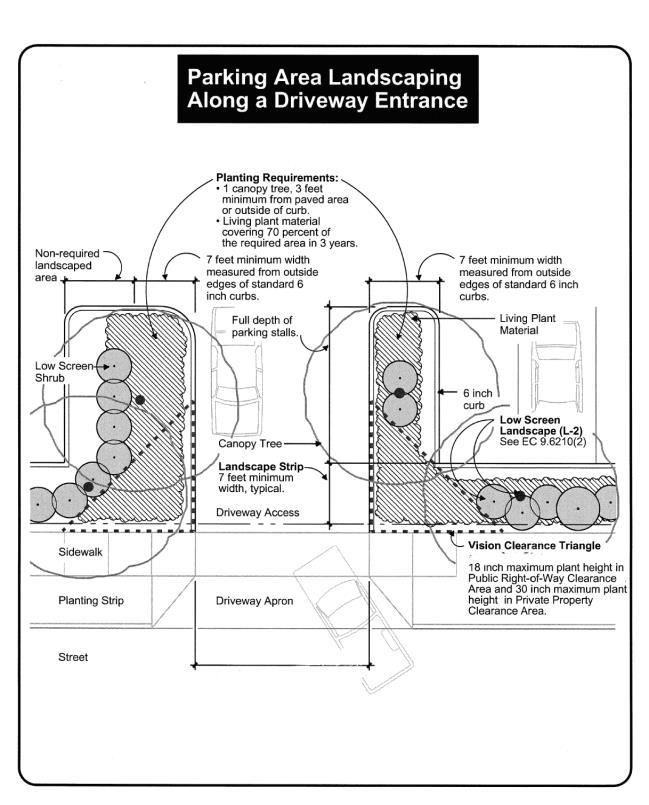
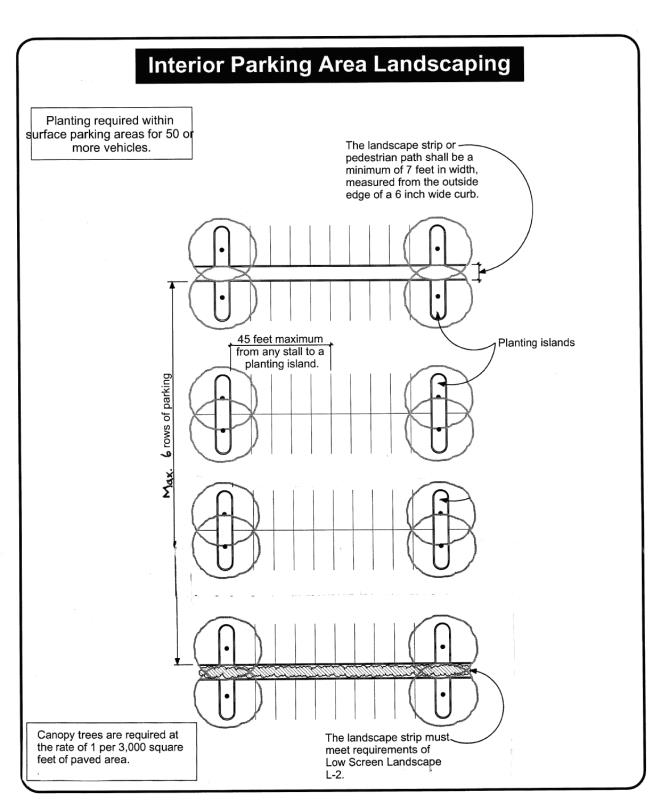
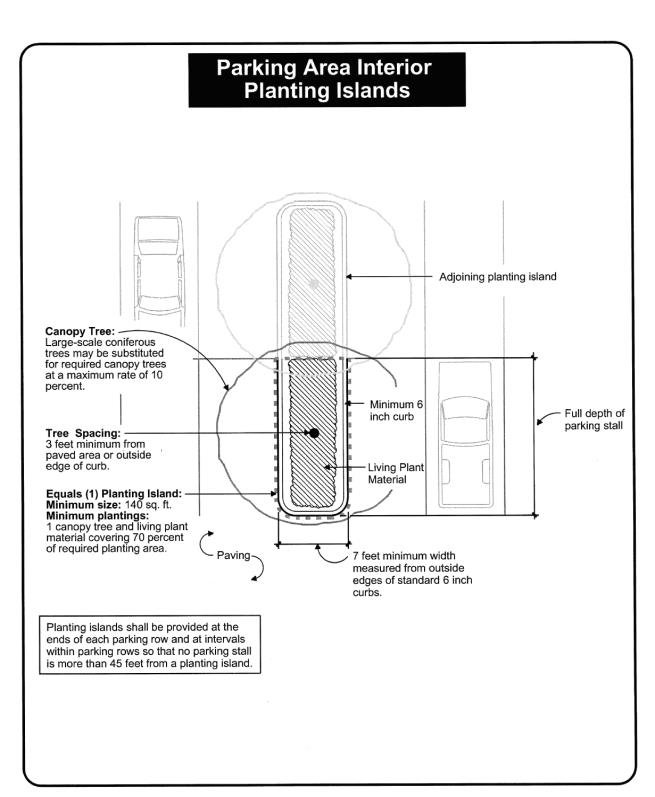
(Ord. 2151 § 1 (Exh. 1), 2020; Ord. 1933 § 4 (Exh. 4), 2016; Ord. 1699 § 1, 2012; Ord. 1400 § 2, 2006)
18.74.150 Landscape maintenance bonds/savings assignments.
A three-year maintenance bond, assignment of savings, or similar account shall be required for landscaping as established by the standards of this code. Bonding/savings agreements shall be adequate to replace landscaping that has died or failed to adequately establish during this three-year term. Such bond shall be posted with the City of Ferndale prior to issuance of certificates of occupancy. (Ord. 1933 § 4 (Exh. 4), 2016; Ord. 1699 § 1, 2012; Ord. 1400 § 2, 2006)
18.74.160 Replacement required.
The City may require the replacement of vegetation and trees which have died, failed to adequately establish, or which have been removed following the three-year term. The intent of this chapter is to provide permanent, attractive landscaping within and surrounding development. Failure to maintain landscaping and/or replace dead plantings shall be considered a violation of this chapter.
Enforcement procedures and the penalties resulting from violations of this chapter shall be administered pursuant to Chapter 1.12 FMC. (Ord. 1933 § 4 (Exh. 4), 2016; Ord. 1819 § 25, 2013; Ord. 1817 § 2, 2013; Ord. 1699 § 1, 2012)


